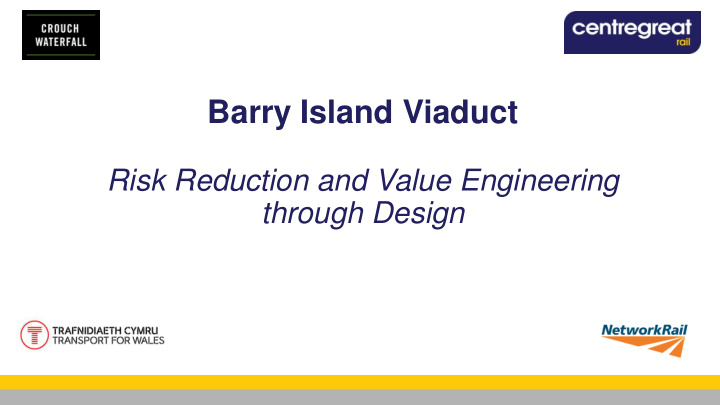



Barry Island Viaduct Risk Reduction and Value Engineering through Design
Presentation Overview Introductions & Summary Description of the Structure Value Engineering Design Optimisation Benefits – Risk, Cost, Time & Carbon Footprint Sustainable Delivery Approach, Behaviour & Culture Any Questions?
Presenters John Hannah – Operations Director – Centregreat Rail Julian Howe – Managing Director – Crouch Waterfall Jarrod Richards – Contracts Manager – Centregreat Rail
Summary: This session will focus on using design as a tool for reducing risk and realising value engineering opportunities. We will map out the journey from challenging ourselves during the design phase, to gaining efficiency benefits in relation to risk, cost, time & carbon footprint during the delivery phase.
Description of the Structure & Scope 18-span steel structure Built circa 1887 Carries a single track of the BRY line and a single track of the Barry tourist railway Simply supported on steel trestles and masonry abutments 4 main longitudinal girders with 3 sets of cross bracing per span Steel deck with longitudinal rail timbers Before works
Description of the Structure & Scope The deterioration of the structure was such that the residual loading capacity did not meet the route availability of the line. Design & Build Contract The following works were undertaken to address the deficiency: Surface preparation and painting Steel work strengthening Steel work repair During works
Value Engineering Alternative assessment model: re-directed the longitudinal forces away from the steel double trestles removed the requirement for significant strengthening works to the steel trestles and their foundations Further advanced studies of the bending forces within the main girders also removed the requirement to over plate all the four main girder bottom flanges across the During works 18 spans
Value Engineering Smart detailing of repairs & strengthening: Maximise normal hours working with ‘live’ loading Innovative temporary works designs: Allowed significant repair & strengthening works to be completed during RoR possessions & mid-week line blockages with additional protection Emergent Defects: Our knowledge & understanding of steel structures allowed early & timely identification, detailing and After works repair
Design Optimisation WHY? The initial assessment was conservative in its findings. However, after 130 years of use, there were no significant signs of distress. The assessment in 2015 showed that the foundations would be failing spectacularly.
Design Optimisation Assumptions Element Previous Assessment Sept 2015 Crouch Waterfall Main Girder Simply supported Simply supported Single trestles to Main Girders Pinned Pinned under vertical loads and fixed under longitudinal loads Single trestles to foundations Pinned Pinned Double trestles to main girder Pinned Pinned under vertical loads and fixed under longitudinal loads Double trestles to foundations Pinned Pinned Abutment bearings Free longitudinally Free longitudinally Deck Full lateral restraint to comp. flange but no composite action Full lateral restraint to comp. flange but no composite action Assumed corrosion loss 10% - 20% 20%
Design Optimisation
Benefits – Risk Reduction Requirement to strengthen double trestle foundations removed: Ground conditions & significant excavation & piling Structure stability, track geometry & monitoring Innovative temporary works: Ensured possessions & line blockages could be handed back if repairs not completed Dynamic & efficient remedy of emergent defects: Cost Double Trestle Programme
Benefits – Cost Alternative assessment model and subsequent design solution offered a 27% cost saving Emergent defects identified, detailed and remedied in a timely manner such that there was no down-time between contracted works & emergent defects: No non-productive costs Prelim / time-related impacts minimised Even with a 50% increase in repairs following blasting operations and the associated programme impact – final account within original authority / funding budget
Benefits – Time Alternative assessment model and subsequent design solution offered: 4 month programme saving Removed the requirement for 4 week blockade Even with a 50% increase in repairs following blasting operations works still handed back within Network Rail financial / funded year
Benefits – Carbon Footprint Reduced programme – time related fuel requirements Reduced out of hours / nigh time working - time related fuel requirements No requirement for 4 week blockade – no bus replacement service No double trestle foundation strengthening – significant reduction in heavy plant usage
Sustainable Delivery Apprentice scheme – directly employed local workforce - A prosperous Wales Litter Pick Barry Island Beach – A resilient Wales Mental Health Awareness Programme – Mates in Mind – A healthier Wales Diverse Workforce – A more equal Wales Future proof the railway asset – A Wales of cohesive communities Welsh Language Signage & Drop in Sessions at the Local Heritage Centre – A Wales of vibrant culture & thriving Welsh Language Local supply chain – Economic Multiplier’s – A globally responsible Wales
Approach, Behaviour & Culture Deliver outstanding value for money to the taxpayer and our customers Make a lasting positive contribution to our lineside neighbours and communities in which we operate Ensure everyone returns home safe from work every day Invest in our people and develop their skills & talent within a culture of diversity, inclusion & mutual respect ‘Be the Best’ attitude Strive for continuous improvement – goal to be ‘ World Class’
Recommend
More recommend